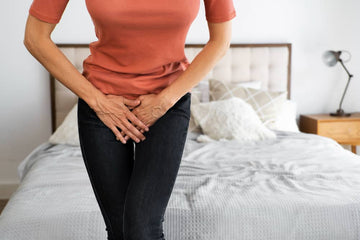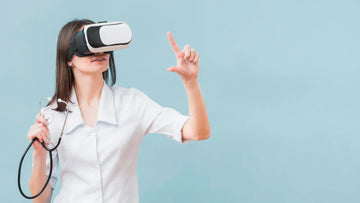Acne, commonly known as pimples, is a common skin disorder affecting the face, back, chest, and other body areas. The labia, a woman's exterior genitalia, occasionally develop pimples. Understanding the causes, prevention, and treatment of pimples on the labia is essential for maintaining excellent intimate health and general well-being, even though it may be uncomfortable to bring up the subject. This post will explore the reasons behind these pimples, how to avoid them, and effective management strategies for this ailment.
What Causes Pimples on the Labia?
Genital or vulvar acne, commonly known as pimples on the labia, can be brought on by several skin-related issues, including hormonal fluctuations, poor cleanliness, and sexual activity. To treat and prevent labia pimples, it is crucial to comprehend their precise causes. Taking a closer look at each of these elements
Blocked Hair Follicles:
When the hair follicles in this area get clogged, pimples on the labia might develop. The skin's hair shaft is housed in microscopic sacs called hair follicles, also related to sebaceous glands that secrete oil (sebum). Dead skin cells, extra oil, and bacteria that clog these follicles produce an environment that promotes inflammation, which results in the development of pimples.
Hormonal Fluctuations:
Hormonal changes significantly influence pimples on the labia. Hormone levels, notably those of estrogen and progesterone, fluctuate during specific phases of a woman's life, including menstruation, pregnancy, and menopause. Due to these hormonal changes, the sebaceous glands may create more oil, which raises the risk of clogged pores and pimples.
Friction and Irritation:
Because they are delicate, the labia are susceptible to irritation from friction. Long-term friction from physical endeavors like exercise or wearing constricting clothing can cause skin irritation and the development of pimples. Additionally, the vaginal region may become inflamed and irritated due to friction during sexual activity.
Ingrown Hairs:
Ingrown hairs can help cause pimples to form on the labia. The hair may occasionally grow back into the skin rather than outward when removal techniques like shaving or waxing are applied. This may cause irritation, redness, and inflammation, which might encourage the growth of pimples.
Hygiene Practices:
Poor hygiene habits in the vaginal area can also cause pimples on the labia. A buildup of sweat, oil, and germs can result from inadequate washing or using abrasive soaps or hygiene products, which raises the possibility of developing pimples.
Sexually Transmitted Infections (STIs):
In a few instances, certain STIs might manifest symptoms that resemble pimples on the labia. For instance, vaginal herpes can result in painful blisters or sores that resemble pimples. If you think an STI may be the source of the problem, getting checked out by a doctor and having the STI suspected is critical.
Allergic Reactions:
Occasionally, skin irritation, redness, and lumps that resemble pimples might be brought on by allergic reactions to specific textiles, laundry detergents, or personal care items used in the genital area.
Immune System Factors:
Pimples on the labia may also form due to a compromised immune system. A weak immune system may find it difficult to fight against bacteria or inflammation, which can result in the development of pimples.
How to Prevent Pimples on the Labia?
Adopting good cleanliness habits and changing your lifestyle is necessary to prevent pimples on the labia. Even while it might not always be feasible to eliminate the risk of pimples, taking the following precautions can greatly lower their occurrence and support the maintenance of a healthy genital region:
Cleanse Gently:
Gently cleanse the labia by using a gentle, unscented soap or an intimate wash designed especially for the vaginal region. Avoid harsh chemicals or perfumes that could hurt this area's delicate skin. Avoid over-scrubbing the region when cleaning it since this can irritate it.
Wear Breathable Underwear:
Opt for cotton underwear that is loose-fitting, breathable, and promotes optimum airflow. Avoid wearing tight synthetic fabrics that can trap heat and moisture, which can foster the growth of bacteria and the development of pimples.
Avoid Tight Clothes:
Wear comfortable, loose-fitting clothing, especially when exercising. Pimples can develop in the vaginal area due to friction and irritation from tight clothing.
Practice Safe Sex:
Use condoms correctly and regularly if you are sexually active to lower your risk of acquiring sexually transmitted infections (STIs), which may show signs similar to pimples. Openly discuss your partner's sexual health with them.
Be Wary of Hair Removal:
If you get rid of the hair on your genitals, avoid ingrown hairs. Use sharp, clean razors and gently exfoliate your skin before shaving to remove dead skin cells. Shaving too closely to the skin should be avoided as this can lead to ingrown hairs and inflammation.
Maintain Hormonal Balance:
If you find hormonal changes related to the emergence of pimples on the labia, you might want to consult a doctor. If you encounter substantial hormonal imbalances during menstruation, pregnancy, or menopause, they may be able to suggest hormonal management solutions.
Keep the Area Dry:
Moisture can encourage bacterial development and make acne worse. Make sure to pat the genital area dry after bathing or swimming properly.
Avoid Popping or Squeezing Pimples:
Popping or squeezing pimples on the labia can aggravate the area and cause infection, scarring, and more irritation. Avoid touching or adjusting the affected region if you can.
Avoid Harsh Chemicals:
To protect the delicate skin in the genital area, avoid using harsh detergents or fabric softeners on your underwear. When washing your underwear, choose hypoallergenic laundry detergents.
Regular Checkups:
Make an appointment for routine checkups with a gynecologist or other healthcare provider to guarantee overall genital health and to address any issues as soon as they arise.
Treatment Options for Pimples on the Labia
Inflammation, healing, and infection prevention are the main goals of treatments for pimples on the labia. While most cases can be treated at home, severe or chronic pimples might need to see a doctor. Here are a few choices for treatment that work:
Warm Compress:
A warm, damp compress on the affected area will help reduce swelling and encourage the pimple's natural drainage. Warmth aides the healing process, calms the skin, and makes the pimple pop.
Topical Creams:
Topical creams sold over the counter that contain salicylic acid or benzoyl peroxide can be used directly on the pimple to assist in unclogging pores and lessen inflammation. These substances can help dry out the pimple and have modest antimicrobial capabilities.
Refrain from Popping Pimples:
Resist the urge to squeeze or pop pimples on the labia. Popping can exacerbate the problem by causing more inflammation, infection, and scarring.
Maintain regular cleanliness:
Managing and preventing zits on the labia requires regular genital cleanliness. Use a gentle cleanser or an intimate wash to clean the region gently. After washing, make sure the area is completely dried.
Medication:
If the pimples are severe or chronic, a medical expert may recommend topical or oral antibiotics to treat the bacterial infection. Antibiotics decrease inflammation and kill bacteria.
Corticosteroid Creams:
A doctor may prescribe corticosteroid creams to lessen swelling and redness in cases of severe inflammation. These creams should only be applied while a doctor is present because prolonged use can have negative consequences.
Avoid Irritating Substances:
Recognize and avoid substances irritating the genital area, such as abrasive soaps, detergents, or fabric softeners. To lessen irritation, choose hypoallergenic and fragrance-free products.
Sexual Restraint:
If rubbing during sexual activity results in pimples, you might want to postpone having sex until the region has healed. As a result, the skin can heal and become less irritated.
Medical Evaluation:
Consult a gynecologist or other healthcare provider if the pimples persist, return regularly, or cause substantial discomfort. They can complete a review to identify the underlying issue and suggest the best course of action.
Hormonal treatment:
A healthcare practitioner may suggest hormonal management measures to balance hormone levels in situations when hormonal changes contribute to the occurrence of pimples.
When to Seek Medical Attention?
If you encounter any unsettling or odd symptoms associated with pimples on the labia, seeking medical assistance is crucial. The majority of labia pimple instances can be treated at home; however, occasionally, a medical examination and course of treatment are required. Here are some situations where you should think about getting medical help:
Severe Pain:
If you have severe pain in the genital region due to pimples, it could indicate a more serious problem that needs to be evaluated and treated by a doctor.
Large or Recurrent Pimples:
A healthcare provider or gynecologist should be consulted for a proper evaluation if the pimples on the labia are especially large, recurring frequently, or not responding to home therapies.
Accompanying Symptoms:
If there are additional symptoms along with the pimples, such as fever, chills, vaginal discharge, or flu-like symptoms, this may point to an infection or other underlying issue that needs to be treated by a doctor.
Increased Redness or Swelling:
If the pimples become more painful, swollen, or red, this may indicate infection or inflammation and require evaluation by a doctor.
Possible Sexually Transmitted Infection (STI):
It's critical to get tested for STIs and consult a doctor immediately if you think the pimples on your labia may be connected to sexual activity and a sign of a sexually transmitted infection.
Existence of Boils or Abscesses:
Genital boils or abscesses may need medical attention because they can be more serious and require incision, drainage, or antibiotic treatment.
Condition Getting Worse:
If the condition doesn't improve with at-home care or over-the-counter remedies and worsens, it's critical to see a healthcare professional for an accurate evaluation and management.
Recurring Symptoms:
A doctor can assist in determining the underlying cause and advising the best course of action if you continue to get pimples on your labia despite taking preventative measures.
Concerns About Skin Changes:
If you observe any unexpected changes in the appearance of your genital skin, such as new growths, discoloration, or bleeding, seek medical assistance immediately to rule out any serious conditions.
Conclusion
Labia pimples can be unsettling and worrying, but their occurrence can be reduced with the appropriate information and preventive measures. A healthier genital area can be attained with proper cleanliness, hormonal balance, and meticulous hair removal. Always remember that prevention is always preferable to treatment, but if pimples develop, contact your doctor to guarantee correct management and prevent any consequences. Taking care of your intimate health is crucial for maintaining a happy and healthy life because it is important to your overall well-being.
Discover the ultimate bliss in productivity with BlissNatural! Unleash your creativity, organize tasks, and boost efficiency like never before. Experience the sleek design and intuitive features of our cutting-edge digital notepads. Elevate your productivity today - visit BlissPads.com and redefine your work-life balance.
FAQs
Where is a sexually transmitted infection (STI) present?.
Yes, labia pimples can occasionally signify a sexually transmitted infection. Some STIs' symptoms, such as genital herpes or genital warts, might resemble pimples. It is critical to get tested and speak with a healthcare provider for an accurate diagnosis and treatment if you engage in sexual activity and detect any strange bumps or sores in the genital region.
Is it typical to get acne on the labia during your period?
Yes, it is usual for hormonal changes related to menstruation to play a role in the emergence of pimples on the labia. Hormonal fluctuations can increase Sebum production, resulting in clogged pores and pimples. Maintaining hormonal balance and basic cleanliness can assist you in dealing with this problem while menstruating.






